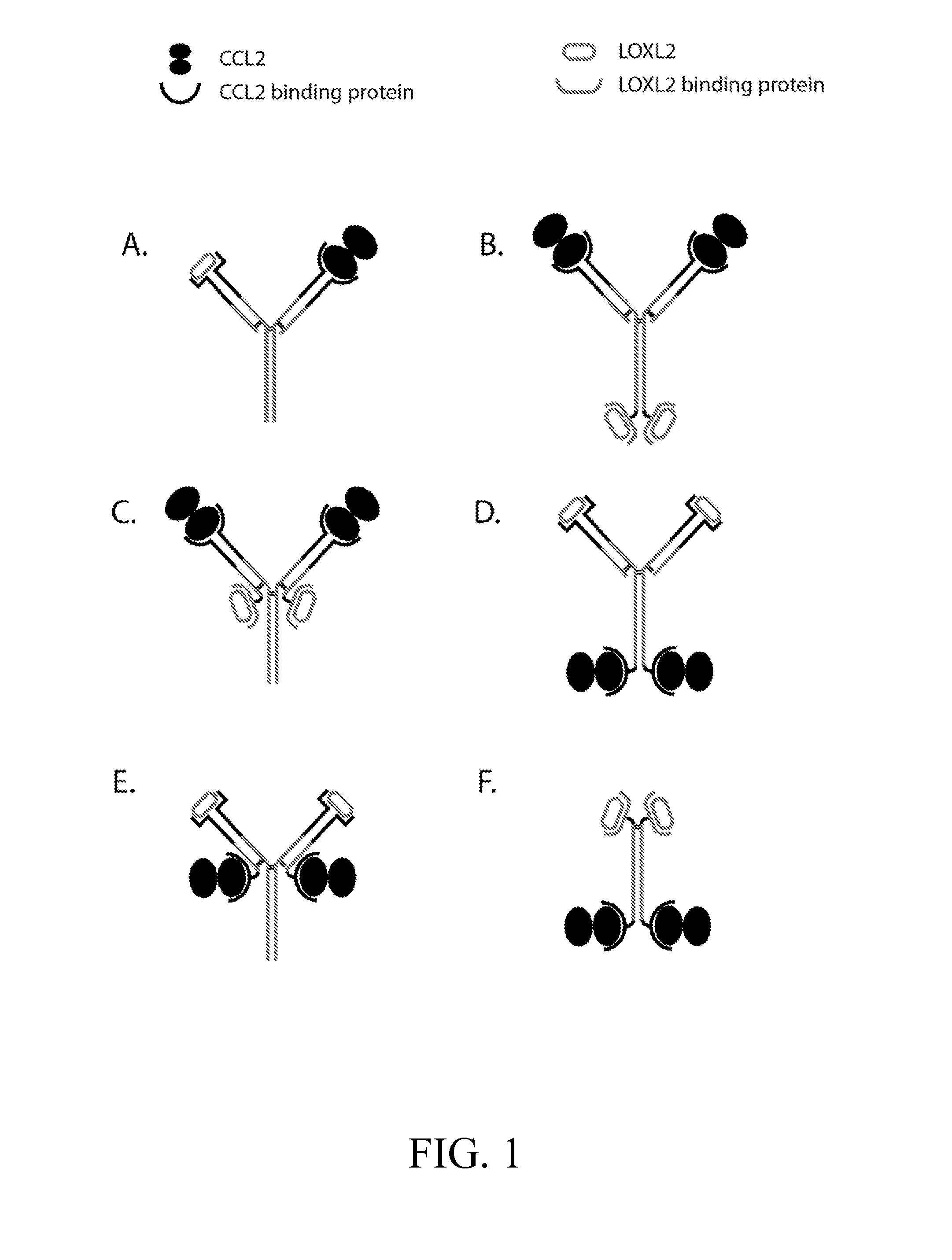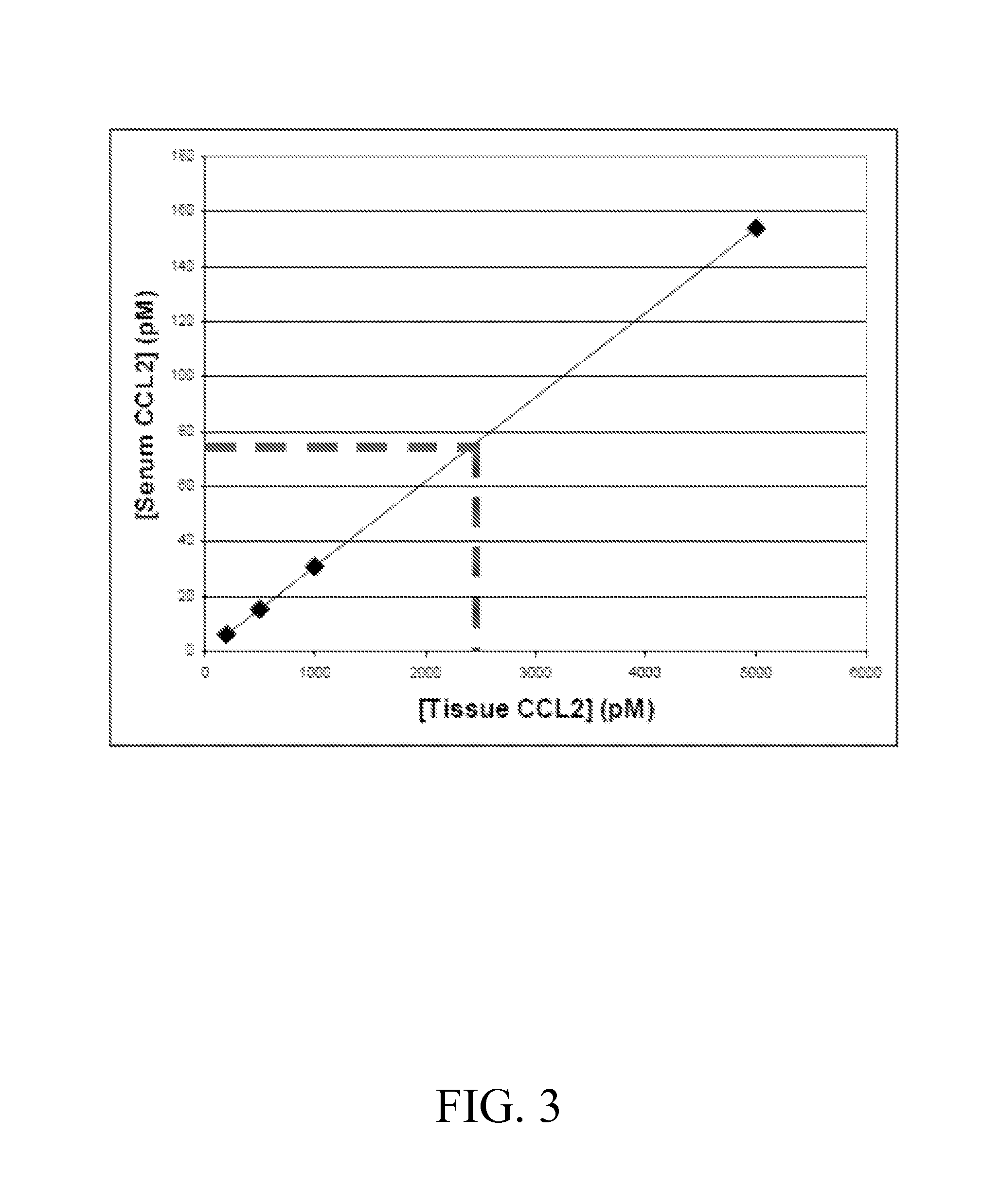Anti-ccl2 and Anti-loxl2 combination therapy for treatment of scleroderma
a combination therapy and anti-ccl2 technology, applied in the field of scleroderma anti-ccl2 and anti-loxl2 combination therapy, can solve the problems of ineffective targeting of ccl2 in diseased tissues, waste of anti-ccl2 antibodies, and ineffective treatment of scleroderma based on anti-ccl2 antibodies, etc., to achieve effective treatment of scleroderma, increase the constitutive expression of ccl2
- Summary
- Abstract
- Description
- Claims
- Application Information
AI Technical Summary
Benefits of technology
Problems solved by technology
Method used
Image
Examples
example 1
Preparation of Bi-Specific Anti-CCL2 / LOXL2 Antibodies
[0205]This example illustrates preparation of bi-specific anti-CCL2 / LOXL2 antibodies. As described above, various methods are available to generate and select bi-specific antibodies with desired specificities and binding affinities.
[0206]In this particular example, the bi-specific antibody is composed of a complete antigen-binding arm against CCL2 and a complete antigen-binding arm against LOLX2. Specifically, a mouse cell line producing a humanized CCL2-specific monoclonal antibody is fused to a rat cell line producing a humanized LOXL2-specific monoclonal antibody to produce a quadroma. Supernatants of quadroma cells are tested for binding to target cells by FACS analysis. Antibodies are purified from quadroma cell culture by protein A affinity followed by ion exchange chromatography.
example 2
Dose Range Testing
[0207]This example illustrates a dose response study designed to evaluate effective dose ranges of bi-specific anti-CCL2 and anti-LOXL2 antibody for treatment of scleroderma.
[0208]A bleomycin induced scleroderma mouse model is used in this example. Typically, fibrosis is induced in mice by repeated subcutaneous injection of bleomycin, polyinosinic-polycytidylic acid and / or LPS into the dorsal skin. Specifically, osmotic pumps (7-day) containing either bleomycin at concentration of 10-110 μg and up to 200 μg, LPS at a concentration of 300 μg, polycytidylic acid at a concentration of 100 μg or PBS alone are implanted subcutaneously into groups of 10 B6 mice. In this mouse model, histopathological changes in the skin closely resembles that seen in scleroderma. Early mononuclear cell accumulation and upregulated TGF-β and chemokine expression is followed by dermal fibrosis characterized by thick collagen bundles and accumulation of activated fibroblasts. Mice also mani...
example 3
In Vivo Efficacy of Bi-Specific Anti-CCL2 / LOXL2 Antibody
[0210]This example illustrates a study designed to evaluate the effect of treatment with anti-CCL2 / LOXL2 antibodies on inflammation and fibrosis in the bleomycin mouse model for scleroderma.
[0211]7 or 28-day osmotic pumps containing either PBS alone or 10-110 μg and up to 200 μg bleomycin in PBS will be implanted subcutaneously into B6 mice. Every two days, mice will be treated via intraperitoneal injection with anti-CCL2 / LOXL2 bi-specific antibody at suitable concentrations, as determined in example 2, or with a control antibody.
[0212]After 7 days, in the case of a 7 day osmotic pump, or 28 days, in the case of a 28 day osmotic pump, skin and lung tissue will be harvested for transcriptional and histological analysis. Levels of CCL2 protein in tissue samples is measured by ELISA. For transcriptional analysis, RNA is extracted from skin tissue and the isolated RNA is subject to and semi-quantitative or quantitative reverse tran...
PUM
| Property | Measurement | Unit |
|---|---|---|
| time | aaaaa | aaaaa |
| time | aaaaa | aaaaa |
| time | aaaaa | aaaaa |
Abstract
Description
Claims
Application Information
 Login to View More
Login to View More - R&D
- Intellectual Property
- Life Sciences
- Materials
- Tech Scout
- Unparalleled Data Quality
- Higher Quality Content
- 60% Fewer Hallucinations
Browse by: Latest US Patents, China's latest patents, Technical Efficacy Thesaurus, Application Domain, Technology Topic, Popular Technical Reports.
© 2025 PatSnap. All rights reserved.Legal|Privacy policy|Modern Slavery Act Transparency Statement|Sitemap|About US| Contact US: help@patsnap.com



